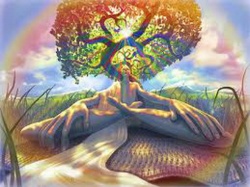Vipassana – Mindfulness of Breathing
There are sixteen methods of Mindfulness of Breathing (Anapanasati) breathing in and breathing out as meditation objects] which Lord Buddha has praised. These sixteen methods of Mindfulness of Breathing are categorized into four groups of four which are called:
1. Mindfulness of the Breathing Body (Kayanupassana),
2. Mindfulness of Breathing Feelings (Vedananupassana),
3. Mindfulness of Breathing Mind (Cittanupassana),
4. Contemplation of Breathing Dhamma (Dhammanupassana).
Each step consists of a pair of breathing in and breathing out. Here is a brief summary explanation, giving both the Pเli and the translation.
1. Mindfulness of the Breathing Body (Kayanupassana)
1. When a monk takes in a long breath, he is mindful that he is taking in a long breath. When a monk lets out a long breath, he is mindful that he is letting out a long breath.
One who practices Mindfulness of Breathing is firmly mindful of breathing in and out. He takes a long, deep breath in and out. When he takes a long deep breath in and out, he is mindful that he is taking a long deep breath in and out. One remains mindful as the breaths become shorter and shorter.
A Reminder: Do not accelerate the rate of breathing or take too long breathing in and out. This could easily make you exhausted. Another reminder: Do not pay too much attention to breathing in and out as this could make you become nervous.
2. When a monk takes in a short breath, he is mindful that he is taking in a short breath. When a monk lets out a short breath, he is mindful that he is letting out a short breath.
When one takes a short breath in, he is mindful that he is taking a short breath in. When one lets a short breath out, he is mindful that he is letting a short breath out. Keep contemplating the breath with mindfulness while breathing in and out until the breathing becomes calm and soft.
3. Mindfully, we will experience the whole breath as we take a breath in.
Mindfully, we will experience the whole breath as we let a breath out.
The definition of “we will experience the whole breath as we take a breath in” and “we will experience the whole breath as we let a breath out” is that the meditator will be mindful continually throughout the process of taking a breath in and letting a breath out, from the start to the end of each process.
The word “will” implies “the future,” so the process of taking a breath in and letting a breath out has not started yet, but it means that the meditator gets ready to practice the meditation.
4. Mindfully, we will calm down the body formation [[[breath]] in and out] as we take a breath in. Mindfully, we will calm down the body formation as we let a breath out.
By constantly contemplating breathing in and breathing out, we calm down the breath like it is about to stop. Some new meditators question why the breathing slows down like that, are we going to die? Some might even stop practicing temporarily. This is just the natural process of the mind becoming concentrated.
Group One is categorized as Mindfulness regarding the body because the breath is recognized part of the body.
2. Mindfulness of Breathing Feelings (Vedananupassana)
Lord Buddha said that one who successfully practices mindfulness of breathing as Kayanupassana will at least attain the first Jhana. Thus, the meditator will start to experience Piti which is Joy or Rapture.
5. Mindfully, we will experience Joy, as we take a breath in. Mindfully, we will experience Joy, as we let a breath out.
Knowing Joy or Piti by concentration or Samadhi means to meditate from the first Jhana to the second Jhana which highlights Piti (Joy or Rapture) because Applied Thought (Vitakka) and Sustained Thought (Vicara) are eliminated. Knowing Piti by Vipassana is contemplating the Three Characteristics of all Compound Phenomena which are that all Compound Phenomena are Impermanent, Suffering and ultimately Non-Self. This can be achieved by contemplating the arising and passing away of Piti.
6. Mindfully, we will experience Peaceful Happiness (Sukha) as we take a breath in. Mindfully, we will experience Peaceful Happiness as we let a breath out.
Knowing Peaceful Happiness by Samadhi is meditating to the third Jhana. The Third Jhana highlights Peaceful Happiness because Joy or Rapture (Piti) is eliminated. Knowing Peaceful Happiness by Vipassana is contemplating the arising and passing away of Peaceful Happiness as well as the Three Characteristics of all Compound Phenomena.
7. Mindfully, we will experience mind-formation (Cittasankhara) as we take a breath in. Mindfully, we will experience mind-formation as we let a breath out.
Cittasankhara means mental formation. It has two key components: (1) knowing Sensation [to know the emotions such as happiness or suffering] and (2) Perception [remembering the sensation such as emotion of happiness or suffering]. Sensation and Perception are in every Jhana, from the first Jhana to the fourth Jhana, but the difference is crude and refined in the order of Jhana levels. Sensation and Perception are called mental formation. [The sensation is the emotion of Happiness which continues through the first to the third Jhana, but in the fourth Jhana, the sensation becomes equanimity (Upekkha).]
8. Mindfully, we will calm down the mental formation as we take a breath in.
Mindfully, we will calm down the mental formation as we let a breath out.
We mindfully calm down the crude mental formation to become more refined [more refine Sensation and Perception -the more refined the mind is, the more calmed it is]. The practices in Group Two are called Mindfulness of Feelings.
3 Mindfulness of the Breathing Mind (Cittanupassana)
9. Mindfully, we will experience and observe the mind (Citta) as we take a breath in. Mindfully, we will experience and observe the mind as we let a breath out.
We experience, observe and contemplate the mind every moment during the process of breathing in and out. When the mind has lust, we know that it has lust, when it does not, we know that it does not. When the mind has anger or hatred, we know that it has anger or hatred. The meditator mindfully knows the condition of mind at every moment.
10. Mindfully, we will experience and observe increasing delight as we take a breath in. Mindfully, we will experience and observe increasing delight as we let a breath out.
We experience and observe increasing delight in two ways: by concentration or Samadhi and by Vipassana. For example, when a meditator attains the second Jhana in which Joy (Piti) predominates, the meditator observes the Joy, this is observing the mind by Samadhi. When the meditator contemplates the arising and passing away of Joy, this is by Vipassana.
11. Mindfully, we will experience and observe the concentration of mind as we take a breath in. Mindfully, we will experience and observe the concentration of mind as we let a breath out.
We experience and observe the concentration of mind in two ways: by Samadhi and by Vipassana. When the meditator’s mind is concentrated with the power of Jhana such as the first Jhana, his mind is concentrated by Samadhi. When the meditator contemplates the arising and passing away of concentration of mind at each moment, this is Vipassana. Momentary concentration (Khanika-samadhi) arises while the meditator is contemplating the Three Characteristics is also Vipassana.
12. Mindfully, we will liberate the mind as we take a breath in. Mindfully, we will liberate the mind as we let a breath out.
We experience and observe the release of the mind in two ways: by Samadhi and by Vipassana. When a meditator attains the first Jhana, the mind is released from all Five Hindrances by the Five Jhana factors. When one attains the second Jhana, the mind is further released from Applied Thought (Vitakka) and Sustained Thought (Vicara). Similarly, attaining the third Jhana releases Joy (Piti) and The Fourth Jhana releases Happiness (Sukha). This is the mind released by Concentration.
By Vipassana,when the meditator leaves the Jhana, he contemplates the arising and passing away [the mind arises, stands and falls] and then releasing the mind from:
• Perception of Permanence through Contemplation of Impermanence,
• Perception of Happiness through Contemplation of Suffering,
• Perception of Self through Contemplation of Non-Self,
• Joy, pleasure or attachment (Nandi) through Contemplation of Disgust,
• Lust (Raga) through Contemplation of Absence of Desire,
• Craving through Contemplation of Extinction of Craving,
• Clinging with Contemplation of Renunciation.
The practices in Group Three are called Contemplation of Mind (Cittanupassana), because they all involve mindfulness of the mind and the four Jhanas, which enable the meditator to contemplate Vipassana of the mind at every level of Jhana.
4 Contemplation of Breathing Dhamma (Dhammanupassana)
13. Mindfully, we will contemplate impermanence over and over as we take a breath in. Mindfully, we will contemplate impermanence over and over as we let a breath out.
The meditator repeatedly contemplates the impermanence of the psycho-physical organism or name and form (Nama-rupa) while taking a breath in and letting a breath out. What exactly does one observe? One observes that the Five Aggregates repeatedly arise and disintegrate instantaneously, every moment, in accordance with the natural law of Conditioned Genesis [[[Body]], Sensation, Perception, Mental Formations and Consciousness]. They have the Three Characteristics of all conditioned phenomena: arising, temporary existence with constant change and then passing away.
14. Mindfully, we will contemplate the abandonment of lust (Viraga) as we take a breath in. Mindfully, we will contemplate the abandonment of lust as we let a breath out.
Abandonment of Lust is the Pali word Viraga which has two meanings:
1. Khayaviraga is abandoning lust with the dissolution and disappearance of the psycho-physical organism [or mind and matter] that occurs every moment.
2. Accantaviraga is ultimate elimination of lust through experiencing Nirvana.
While taking a breath in and out, a meditator contemplates that dissolution of the Five Aggregates occurs all the time. As a result, one is able to abandon lust or reduce the level of lust in the Five Aggregates. This is Khayaviraga.
A meditator who contemplates Nirvana observes the characteristics of the Unconditioned. There is no growing old, getting sick or dying, no persistence with content change and no passing away. It is ultimate happiness. This is the opposite of the Five Aggregates which dissolve each instant. Thus, the meditator becomes bored with lust for this sensual world (Sankhara) and takes Nirvana as his basic inner sphere of reference. This is Accantaviraga.
15. Mindfully, we will contemplate Extinction of lust (Nirodha) as we take a breath in. Mindfully, we will contemplate Extinction of lust as we let a breath out.
The Pali word Nirodha has two meanings:
1. Khayanirodha means extinction or termination of lust and craving.
2. Accantanirodha means complete extinction of all lust and all craving by experiencing Nirvana.
16. Mindfully, we will contemplate detachment (Patinissagga) as we take a breath in. Mindfully, we will contemplate detachment as we let a breath out.
The Pali term Patinissagga or detachment has two meanings:
1. Pariccagapatinissagga is detaching by donation which means sacrifice without residual longing.
2. Pakkhandaparicca is detaching by fleeing from defilements including the Five Aggregates and Formations (Abhisanghara) which means Karma [formation of merit, demerit and the imperturbable such as the Formless Brahman]. This leads only straight to Nirvana.
Group Four is Contemplation of dhamma (Dhammเnupassana). It is only Vipassana where as Groups One, Two and Three are both Samatha and Vipassana.








